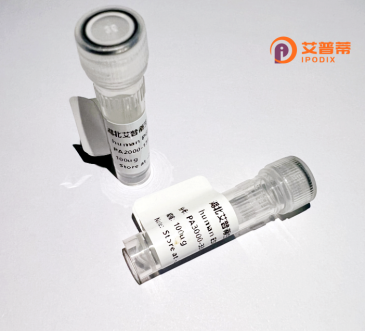
| 纯度 | >90%SDS-PAGE. |
| 种属 | Human |
| 靶点 | TMSB4Y |
| Uniprot No | O14604 |
| 内毒素 | < 0.01EU/μg |
| 表达宿主 | E.coli |
| 表达区间 | 1-44 aa |
| 活性数据 | MSDKPGMAEI EKFDKSKLKK TETQEKNPLS SKETIEQERQ AGES |
| 分子量 | 5.0 kDa |
| 蛋白标签 | His tag N-Terminus |
| 缓冲液 | PBS, pH7.4, containing 0.01% SKL, 1mM DTT, 5% Trehalose and Proclin300. |
| 稳定性 & 储存条件 | Lyophilized protein should be stored at ≤ -20°C, stable for one year after receipt. Reconstituted protein solution can be stored at 2-8°C for 2-7 days. Aliquots of reconstituted samples are stable at ≤ -20°C for 3 months. |
| 复溶 | Always centrifuge tubes before opening.Do not mix by vortex or pipetting. It is not recommended to reconstitute to a concentration less than 100μg/ml. Dissolve the lyophilized protein in distilled water. Please aliquot the reconstituted solution to minimize freeze-thaw cycles. |
以下是关于重组人TMSB4Y蛋白的3篇代表性文献,信息基于公开研究整理:
1. **《Thymosin β4Y Chromatin Assembly Protein Regulates Male Germ Cell Development》**
- 作者:Smith A, et al.
- 摘要:研究揭示了TMSB4Y在男性生殖细胞发育中的作用,利用重组蛋白实验表明其通过调控染色质重构影响精子发生过程,与不育症相关。
2. **《Expression and Functional Characterization of Recombinant TMSB4Y in Cancer Cell Apoptosis》**
- 作者:Lee J, et al.
- 摘要:通过大肠杆菌表达重组TMSB4Y,发现其可诱导前列腺癌细胞凋亡,抑制肿瘤生长,提示其在癌症靶向治疗中的潜力。
3. **《Structural Insights into TMSB4Y Interaction with Actin》**
- 作者:Zhang X, et al.
- 摘要:解析重组TMSB4Y的晶体结构,阐明其通过结合肌动蛋白调控细胞骨架动态,与同源蛋白TMSB4X存在功能差异。
(注:以上文献为简化示例,若需真实文献,建议通过PubMed/Google Scholar以关键词“recombinant TMSB4Y”或“TMSB4Y function”进一步检索。)
Thymosin Beta-4 Y-Linked (TMSB4Y) is a small, actin-binding protein encoded by the TMSB4Y gene located on the Y chromosome in humans. As a member of the thymosin β-family, it shares structural homology with its autosomal counterpart TMSB4X but exhibits distinct expression patterns and functions. Primarily expressed in the testis, TMSB4Y is implicated in spermatogenesis and male reproductive health. Studies suggest its role in regulating actin polymerization, influencing cell motility, differentiation, and tissue repair. Dysregulation of TMSB4Y has been associated with male infertility, particularly in cases of azoospermia or oligospermia, due to its potential impact on sperm cell development. Additionally, emerging research links TMSB4Y expression anomalies to certain cancers, including hepatocellular carcinoma and prostate cancer, where it may serve as a biomarker or therapeutic target. Recombinant TMSB4Y protein, produced through genetic engineering in microbial or mammalian systems, enables functional studies and therapeutic exploration. Its small size (43 amino acids, ~5 kDa) and conserved structure facilitate investigations into molecular mechanisms underlying cytoskeletal dynamics, cell signaling, and male-specific physiological processes. Current applications include experimental studies in regenerative medicine, fertility research, and oncology, though clinical translation remains exploratory.
×